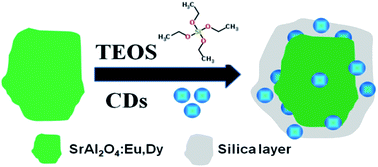Carbon dot grafted SrAl2O4:Eu,Dy dual-emitting phosphor for ratiometric temperature sensing
Abstract
A simple and effective strategy has been carried out to design a ratiometric temperature sensor in this work. Carbon dots (CDs), which benefit from surface methoxysilyl groups after using an organosilane as a coordinating solvent, are highly reactive intermediates responsible for bonding with silanols and hydroxyl groups from the silica-coated SrAl2O4:Eu,Dy phosphor (SAO). Hence, a CD-grafted SrAl2O4:Eu,Dy phosphor (CD–SAO) could be realized using a facile one-step sol–gel method. The as-prepared CD–SAO shows the characteristic fluorescence emissions of CDs (blue) and SAO (green) at a single excitation wavelength. The temperature dependence of the fluorescence intensity ratios for the two emission bands was studied, and it turned out that the composite has a wide linear temperature sensing range, which matches well with physiologically relevant temperatures. This rather simple approach for creating dual emission enables a completely new strategy for the application of these composites in temperature sensing.


 Please wait while we load your content...
Please wait while we load your content...